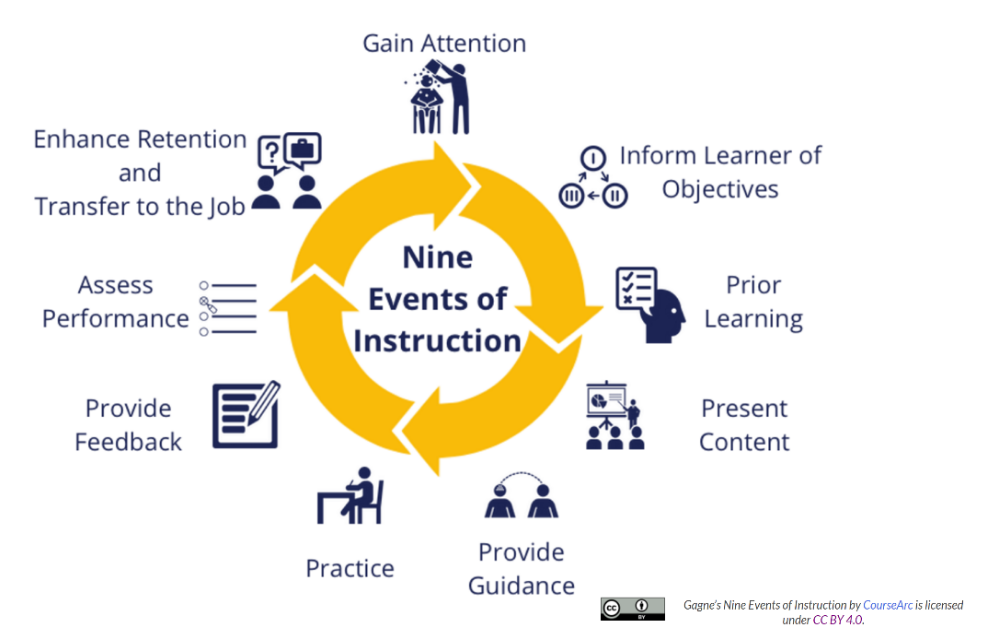Robert Gagne's Nine Events of Instruction supports the sequencing of learning and teaching to enhance student engagement and learning.

Source: Lesson planning, Singapore Management University Centre for Teaching Excellence.
This process can be applied within online learning content to provide guidance about how to sequence online learning content and activities to support students to learn and make meaningful connections.
The following steps have been adapted from Gagné, Briggs, and Wager (1992) and Northern Illinois University Center for Innovative Teaching and Learning (2020).
This is an opportunity to hook the learner and draw them into the learning content. Consider trying to bring in elements that stimulate interest by being novel, unexpected, or surprising.
This can be achieved in several ways but might include:
This can also form a golden thread (recurring thematic metaphor) in which you weave through the entire topic to connect concepts or tie things together for the learner.
Help students to understand what is expected of them for this topic. Help them make connections to how these expectations about what they will learn and do relate to the entire subject and to their emerging professional identity.
This supports students to organise their thoughts and prioritise their attention.
Consider:
It is easier to learn something new when students can attach it to something they already know. Prior knowledge activation via a learning activity can improve comprehension of new information.
Some methods for stimulating recall:
Now is the perfect time to present new content to your students. It is important to consider the sequencing of the content and how to organise and group content to make meaningful connections for the students.
Teacher explanations and insights can be a powerful way to help students learn.
Some useful strategies for presenting content:
Your role as the teacher gives you the opportunity to give students insights into how to learn and ways of engaging with the concepts being presented in effective ways.
This is a powerful strategy and helps students learn how to learn.
Some useful strategies for providing learning guidance:
Getting students to apply their learning reinforces new knowledge and skills. It also allows students to confirm their understanding and abilities which is crucial for developing independent learners.
Some useful strategies for activating learner processing:
Timely feedback about student performance can facilitate learning and encourage students to self-assess gaps in their learning prior to weighted assessment.
Confirming a student did what they needed to do can be a great way to reinforce performance and motivate students to continue. This type of feedback does not feature any information about improvement.
Within learning content, this can be as simple as providing a connection between the new learning and upcoming weighted assessment.
More broadly this references the assessment schedule for the subject and how it works to guide, reinforce and assess progression towards mastery of learning outcomes.
Ensuring alignment between your learning outcomes, learning content, and learning activities, and assessment ensures students are prepared for the requirements of assessments.
A variety of assessment methods and modes will give students multiple opportunities to demonstrate proficiency. Authentic assessment, including industry-relevant text types, is recommended to enhance skill and knowledge acquisition.
Provide connections to real-world application and to previous and upcoming learning to enhance retention.
Associate the new learning with other concepts and consider providing review opportunities that cover previous learning to reinforce the connected nature of the learning.
Consider getting students to create a summary of their new learning or convert key information from one format to another (text into a concept map, etc.) to enhance retention.
Provide reflection and closure to any guiding questions or themes within your topic.
Gagné, R. M., Briggs, L. J., & Wager, W. W. (1992). Principles of instructional design (4th ed.). Forth Worth, TX: Harcourt Brace Jovanovich College Publishers.
Laurillard, Diana. (2012). Teaching as a design science. In Routledge, Taylor & Francis Group. Routledge.
Northern Illinois University Center for Innovative Teaching and Learning. (2020). Gagné’s nine events of instruction. In Instructional guide for university faculty and teaching assistants. Retrieved from https://www.niu.edu/citl/resources/guides/instructional-guide
Schuell, T. J. (1986). Cognitive conceptions of learning. Review of Educational Research, 56, 411-436.
Singapore Management University Centre for Teaching Excellence, Lesson planning. Retrieved from https://cte.smu.edu.sg/approach-teaching/integrated-design/lesson-planning
The University of Queensland, Institute for Teaching and Learning Innovation, Designing learning activities Retrieved from https://itali.uq.edu.au/teaching-guidance/teaching-practices/designing-learning-activities